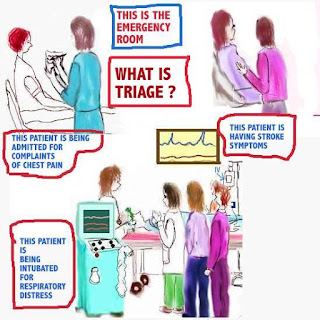UNDERSTANDING THE ROLE OF THE TRIAGE NURSE

In the image above, there are three different scenarios. 1) A patient is having complaints of chest pain . 2) A patient is having stroke symptoms. 3) A patient is being intubated for respiratory distress. What is the role of the Triage nurse? The Triage nurse has the responsibility of prioritizing which patient is critical and needs immediate attention when working in the ER. Each scenario tells its own story. Enjoy watching the video: Triage nurse for more information. In this Emergency Room scenario, a patient has been transported to the ER. Medical staff members are gathered around the bedside. It takes "all hands on deck" to complete the work. It is important to recognize that classroom skills are different from clinical skills . A nurse's performance in the work place takes on a different challenge from the classroom. Trauma can sometimes be prevented!
















